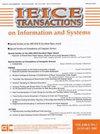变脉冲序列多功能雷达模式识别的无监督技术
IF 0.6
4区 计算机科学
Q4 COMPUTER SCIENCE, INFORMATION SYSTEMS
IEICE Transactions on Information and Systems
Pub Date : 2023-11-01
DOI:10.1587/transinf.2023edp7007
引用次数: 0
摘要
具有不同脉冲序列的多功能雷达(MFR)可以根据目标的存在改变其信号特性和/或模式,以避免被阻塞。为了采取对抗MFR的对策,电子战(EW)系统能够在没有先验知识的情况下,通过分析截获的雷达信号来识别和分离MFR的模式,这是至关重要的。在本文中,提出并研究了两种基于相关的方法,一种是考虑信号的顺序,另一种是忽略信号的顺序。结果显示了它们的巨大潜力。本文章由计算机程序翻译,如有差异,请以英文原文为准。
Unsupervised Techniques for Identifying the Mode of a Multi-Functional Radar with Varying Pulse Sequences
A multifunctional radar (MFR) with varying pulse sequences can change its signal characteristics and/or pattern, based on the presence of targets and to avoid being jammed. To take a countermeasure against an MFR, it is crucial for an electronic warfare (EW) system to be able to identify and separate a MFR's modes via analyzing intercepted radar signals, without a priori knowledge. In this article, two correlation-based methods, one taking the signal's order into account and another one ignoring the signal's order, are proposed and investigated for this task. The results demonstrate their great potential.
求助全文
通过发布文献求助,成功后即可免费获取论文全文。
去求助
来源期刊

IEICE Transactions on Information and Systems
工程技术-计算机:软件工程
CiteScore
1.80
自引率
0.00%
发文量
238
审稿时长
5.0 months
期刊介绍:
Published by The Institute of Electronics, Information and Communication Engineers
Subject Area:
Mathematics
Physics
Biology, Life Sciences and Basic Medicine
General Medicine, Social Medicine, and Nursing Sciences
Clinical Medicine
Engineering in General
Nanosciences and Materials Sciences
Mechanical Engineering
Electrical and Electronic Engineering
Information Sciences
Economics, Business & Management
Psychology, Education.
 求助内容:
求助内容: 应助结果提醒方式:
应助结果提醒方式:


